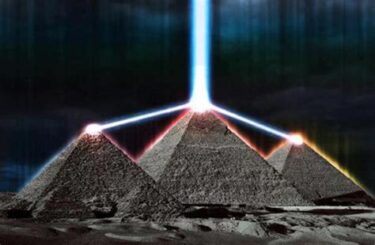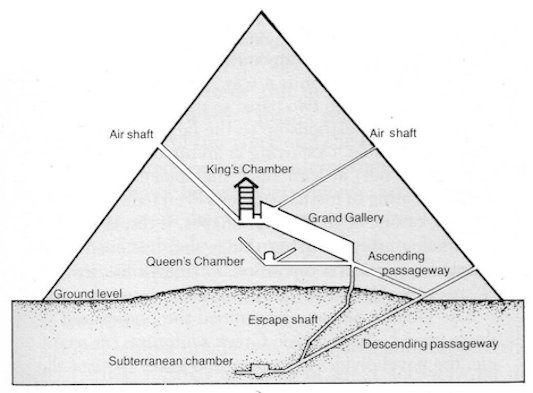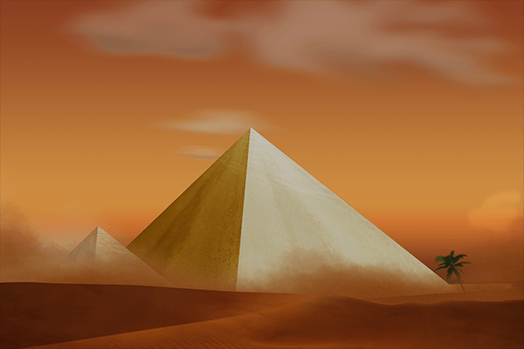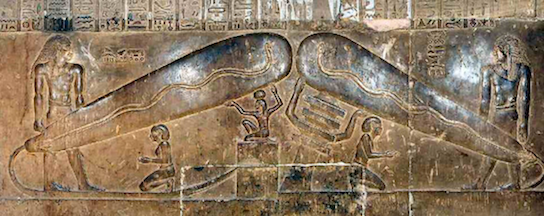Devastated by a great earthquake in 1303 and further removed, transported away for other purposes in the area, the used-to-be outer-layer, the white casing stones made of finely polished limestone would have served as perfect insulation to the inside:
The remaining pyramid’s inner-surface had been treated with dolomite, a mineral known to have an involvement in increasing electrical activity in direct relation to the amount of pressure applied: The higher the pressure, the greater the electric current generated.
Further, below the base, the pyramid has a number of underground tunnels lined with the mineral granite which is mostly made up of quartz and is treated with metal. This is significant when considering that this allows the conduction of piezo electricity when subject to stress or pressure.
In short and simple terms, the granite has the effect of ionizing the air surrounding inside the Great Pyramid, followed by a chemical reaction which in turn increases the conductivity of the electricity. The increased electrical flow then bypasses pieces of rock via metal wire having the net effect of further amplifying this electrical flow, quite sizably in fact… -Do you still think that this was just a burial ground?! Read on.
It has been said that this upward-direction of amplified electricity generation needed a catalyst to make it happen: It had been produced in conjunction with underground aquifers from below the base of the pyramid. The flowing waters needed to form the aquifers and naturally generate a current had come from the river Nile which used to flow at the pyramid and beyond.
It has been put forward that the water went upwards into the limestone through capillary attraction: A small area gets wet then transfers this wetness to the next region. This next region then transfers water to another region and so on… This transference of water keeps happening until the whole area is wet.
It happened in conjunction with a series of tunnels: One leading down below the base of the pyramid which contacted the aquifer water below. This water contact caused the water to flow upwards through this tunnel. Then the water continued its upwards flow through contacting other tunnels channelling the water passing over the surrounding limestone. Thus, the water could have gone all the way to the top of the great pyramid.
It has been said that the Great Pyramid’s tunnel would have received vibration and stress during this upward water flow resulting in the generation of Piezo electricity during the high force pressure changes. Like the water, upward-conducting generated electromagnetic energy also made its way towards to the top where a gold capstone was said to be (now missing as this valuable precious metal was supposedly looted).
The gold could have been an energy-directing source. The electrical energy coming from the pyramid could have then been fed high up into the ionosphere via the gold capstone.
The Great Pyramid of Giza just happens to be at a location where Earth’s natural electromagnetic forces can be magnified and telluric currents have been found to be at their strongest. Hence, the reason for a powerful electromagnetic field coming from the pyramid’s base which would have travelled upwards with the aid of chemicals reactions…
-This ties in with the idea that Nikola Tesla was extremely interested in the pyramids and it was thought that he devised his Tesla tower based on the Great Pyramid of Giza.
Tesla, in the early 1900’s asserted that at an altitude of 30,000 feet high, the stratum of rarefied air there was capable of conducting high voltage electric currents. With this in mind he devised a system, a Tesla Tower was set up in order to transmit extremely high voltages going into the atmosphere. Then at the ground-level a sort of rod, give or take a few modifications, was there to receive the energy and act as a voltage lowering device. With the lowered voltage energy this made it potentially available to many consumers…
However, instead of Tesla’s intention happening, to ultimately create a system where everybody could have extremely cheap electricity, this project was quashed. Energy baron funder J.P Morgan withdrew funding using his monopoly and wealth to have
Tesla and his project destroyed instead, as it was perceived as a threat to his oil/gas-based energy business.
-That’s why this form of wireless electricity generation technology was never known to us and kept under wraps…




